
In fact, most of the fastest typers in the world still use the standard QWERTY layout. In reality, the fastest layout is the layout you already know. While the Dvorak and Colemak layouts were designed to increase speed and efficiency, these layouts can take a long time to learn (and even longer to master!). And many more Which Keyboard Layout Is Faster? QWERTY vs Dvorak vs Colemak.Sholes (created by the inventor of QWERTY later on in his life).QWERTY, Dvorak, and Colemak are the most common functional layouts, but there are also… There are actually several alternative layouts. That, and it’s set up for the hands to alternate, left, right, left, right. In 1936, August Dvorak developed his own layout, with commonly used letters closer to where the fingers naturally rest on the keyboard (making the typing experience more comfortable and efficient). One of the problems with the standard QWERTY layouts is how much your fingers need to move, stretch, and bend to type. QWERTY dates back to the days of early typewriters, where you could actually jam up the machine by typing too fast!Ĭhristopher wanted to put vowels and the more common letters farther apart from one another. The QWERTY is the most common keyboard layout, probably because it is the oldest and most commonly used!įun Fact: A man named Christopher Sholes invented the QWERTY layout to actually SLOW DOWN the typing experience. What Is the Standard Keyboard Layout? Answer: QWERTY Two popular alternatives are Dvorak and Colemak, which were designed to be more efficient and faster for typing. There are many alternatives to the “QWERTY” layout, which is the standard all across the world. There’s also a JIS layout specifically for Japanese keyboards, which features a smaller space bar (to make room for more keys), and a few other small changes! What Are the 3 Types of Keyboard Layouts?
#Picture of french keyboard layout iso#
but like those big & fat Enter keys, then get you an ISO layout keyboard! ? It should be noted that you can use different layouts no matter where you’re located! If you’re in the U.S. ISO features the taller Enter key, and the backslash key is over to the left besides the left Shift key! The ISO layout is commonly found internationally (ISO stands for “International Organization for Standardization”).

This layout features a wider left-Shift key, and a wider Enter key with the backslash key just above it. The ANSI layout is most common in the United States (ANSI stands for “American National Standards Institute”).

You can remap and reprogram keyboards in a number of ways! We’ll talk about QWERTY, Dvorak, and Colemak layouts below.īefore we review standard layouts for typing, let’s explore the physical layouts that are out there. In other words, what is triggered when you press the key? In most cases, the functional layout should match the visual layout. Functional layout The mapping of each key. Visual layouts vary depending on country, language, etc. Visual Layout The symbols printed on each key. The most popular physical layouts are ANSI, ISO, and JIS. Here’s a quick breakdown: Physical layout The arrangement of the keys on the keyboard. The word “layout” could actually mean different things, so let’s clarify these: Summary: There Is No Optimal Keyboard Layout! What Are Keyboard Layouts?.



 0 kommentar(er)
0 kommentar(er)
